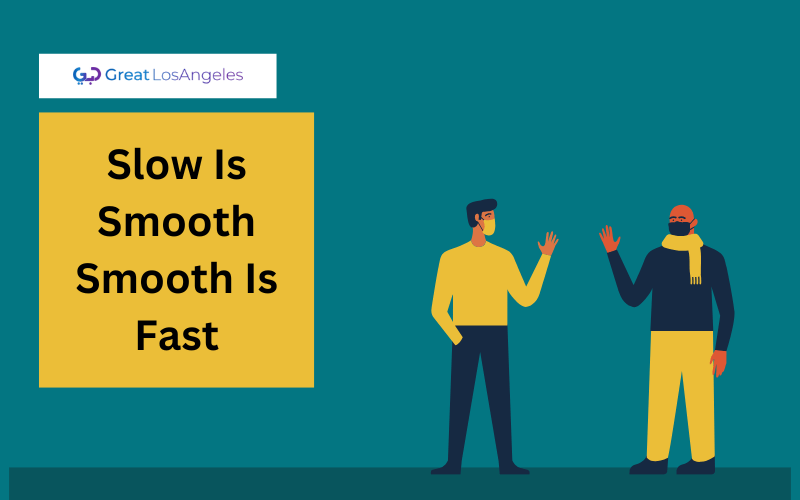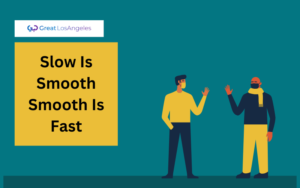Analyzing the Concept of ‘Slow is Smooth, Smooth is Fast’
Smooth is Fast – Sisf Meaning
The phrase used is “slow is smooth smooth is fast” This simply means that if one is slow in what he/she does, and if that individual ensures that every step is done thoroughly and correctly then the results would be faster and of higher quality. It is about being wary not to impose haste because that always leads to a loop and more errors to be made.
Process of Mastery
In stating that haste makes waste, what you’re doing is allowing yourself to get it right through practice. Recreation of oil painting must be done patiently as any other skill that is practiced thereforeattempting to achieve quick results in painting only leads to inefficient painting and a full understanding of the whole process.
Why Slowing Down Enhances Speed in the Long Run?
The Results Obtained Much Faster
Initially, you might think that taking your time is counterproductive, but this is the productive way. Panic causes the mistakes to emerge which then need remedial action to be taken. As with deliberate action, you do not make faulty decisions, therefore your actions are more effective, and thus faster. It means that mistakes waste your time in the process while a methodical approach helps to achieve progress step by step.
Deliberate Practice and Efficiency
Repetition is the mother of efficiency The basic fact of efficiency is that By practice, it becomes efficient. If you make your actions deliberate then you are building up your skills in a way that your gesture becomes more precise and fluid with time. This focus on improvement leads to much better performance, and yet improved work does not mean haste, whereas improving work with haste leads to decreased quality performance.
Putting the Philosophy to Work and Productivity
Slow and Steady Work
At the workplace, this behavior only leads to decreased quality in productivity and workplace exhaustion. In this case, it enables one to move through to the other tasks with a great deal of accuracy than when rushing through the task. As with any task, you should take the time to look for solutions and apply yourself through repetition, so your efforts are more effective in the long run while gaining value and insight into your work.
Decreasing Stress by Being Organized
In this way, you will be able to handle your activities within the day without getting to over-exert yourself through rushing. It minimizes the pressure that comes with the deadlines, and because you are focused you break the work into achievable sub-goals. Because when you come to the same activities with a purpose, you have fewer chances of making wrong decisions and fewer chances of getting stressed.
The Great Mindset for TransformationSelf-Discipline and Achievement
The fourth principle in the slow is a smooth school of thought is all about self-control. Let me elaborate on it to you guys In layman’s terms. They make you slow down and not rush through things which in turn helps you get focused and stick with it. Consistency over a fast pace of work is valuable as it assists in building good practices necessary for self-growth.
A Sustainable Approach
When you are patient with the progress it is easier to build long-term habits. Repetition mastery is the central tactic that has to be employed in relation to the given habits. This way you implant the necessary skills for effectiveness and when it is done in a slow manner, it ensures that the process is strengthened.
Why Other Champions Use It?
How do Sports relate to the kinetic chain?
In sports, everyone understands that speed must always come with accuracy. Whether you consider a tennis serve, an attempt to run sprints, or a golf swing, putting more precision and fluidity in achieving functional ideals will lead to a reduction in the rates of error. By adopting deliberate actions, the improvement of the motor programs, and in effect the movement, becomes faster and smoother during the course of the competition.
Who Practices on Purpose?
Most prominent athletes apply a principle of movement, slow is smooth smooth is fast to enhance performance. Both of them are based on rehearsing their movements and then practicing those movements until the movements become second nature as a result. Such dedication to the methodical progress of training enables them to excel under increasing pressure which in turn proves that success is made through months, years, and not days.
The Benefits of Moving with Intention
How does being Deliberate increase quality?
This is because, when you move with intention, you are actually devoting your total concentration to what you are doing. This results in increased quality of the work being delivered since one is concentrating on the small aspects rather than on the time utilized. In project execution, or even while growing a skill, good focus means that all actions done are purposeful and guarantee lasting achievements.
Building Consistency Through Intensity
It is more important also when to be consistent than to be fast. By now, it must be clear to you that by taking consistent action each and every day, you are building the momentum that results in permanent positive change. The cognitive load approach is to select one task at a time and put effort diligently into it so that no mistake is committed, and there is no jumping back and forth. In consequence, the work performed shall be much more efficient and its quality higher.
The Psychological Benefits of ‘Slow is Smooth’
Managing Stress
Steady motion enables you to well control intense pressured situations in life with the required attention and efficiency. One common problem observed in fast-paced work settings is that you may find yourself fretting and hurried. However, positive thinking at a later tempo is less stressful and allows for proper evaluation. If you are not under pressure you can consider solutions better, and make choices more consciously.
Study Highlights-Solving Skills
This means that since a person are stressed the moment they are faced with challenges they initially make hurried decisions, and the calm moments come up with better decisions. This way, you ensure that you approach problems with a clear mind that also has better judgment as compared to when everyone is rushing. These pains taken over hasty work ensure you cover tough situations without feeling choked through easy and successful problem-solving the Urge to Rush.
Errors and Experience Failures
This of course is counterproductive mainly because when one rushes they end up making mistakes, which causes further setbacks. If this is done hurriedly, the possibility of leaving out important details is very high since most of the focus is made on speed. Of course, it is better to move slowly and make a mistake than to hurry through the process and have to go back and correct it. I just think that when you rush a project, you risk a lot of complications that end up in having to redo some work.
Instant Gratification
As a way of avoiding this kind of pressure, it may be useful to chop down tasks into small segments. The best way is to allot a a particular number of hours to particular activities and do not stress about how soon you have to complete them. SA’s steady and slow but sure approach and learning to take it step by step toward your goal will eventually aid in constructing a much more effective procedure.
Learning to Trust the Process
How does trusting the journey enable one to master it?
Mastery takes time. This is the beauty of trusting the process and accepting to build your fitness gradually; you provide yourself with the best chances of enhancing your fitness level. This is how every head of a field becomes a recognized expert in the specific field of practice. Trust the process is truthfully the slow and steady approach to whatever goal and it’s okay because steady wins the race isn’t it?
Process of Implementing Change
In the process of achieving mastery, it is highly recommended to focus on minor achievements. It means that every single move you make is a forward movement. What they obtained is a fact that one should not tirelessly push away the bad feelings though they should not forget to remember the achievements they got no matter how minor they are. If you trust the process of deliberate action it will take you to the bigger picture in the long run.
The Lesson for Everyday Life: Slow is Smooth
Decelerating Yet Not Stalling
You don’t need to be idle, but incorporating active breaks can be healthy even if it is only for ten to fifteen minutes at a time. Sort the goals mathematically, reduce interfering stimuli, and work on a single goal for a while. That translates to mean that while you may be slow does not necessarily mean that you are not getting as much done as you should; it only means that you are getting a lot done in a very efficient manner.
Waiting and Working
The key is to be as patient and serious as you have to be, but not more, and to be as active and advanced as you need to be, but not more. One is that the process should be gradual but there at the same the process should go on constantly. If you decide to concentrate on quality, you will invest your time in making real changes while avoiding any haste.
Frequently Asked Questions (FAQs):
What has Slow is Smooth Smooth is Fast got to do?
It means simply that it’s more efficient to spend the extra time to be careful and purposeful. If one becomes rushed, one can make mistakes and also create more time-wasting incidents.
How can slowing down be beneficial for increasing my productivity?
If you go slower, there are fewer errors, higher/higher quality work, and more sustainability, which increases long-term efficiency.
Can I generalize this practice in my career?
Absolutely. Taking time on your work rather than rushing can result in better results and fewer mistakes besides enhancing your rapport with your fellow workers.
In what manner does work in sports?
Expert performers taking slow, controlled steps while performing on the field move fluently especially achieving high accuracy, and are less likely to get injured.
Should one always take a break and lighten the pace in life?
Not always. However, in the majority of the situations, gradual work emerges more effective in terms of relatively steady achievements rather than the reckless and hasty work pace.








